Maintaining a balance of physical, social and emotional wellness has become a challenge for many in the age of COVID-19. Swimming is a noncontact physical activity that lets you be socially distant while still receiving many health benefits. Exercising in water can increase cardiac function, reduce blood pressure and improve muscle blood flow, respiratory function and brain function. Water reduces joint impact, so you can do high-intensity exercise with little to no discomfort from impact. Swimming targets your entire body and allows a greater range of motion for joints than land-based exercise. Blood flows more freely to your upper body while the water supports you and lowers gravity’s impact.
Swimming is an amazing yet underutilized way to meet the American College of Sports Medicine (ACSM) physical activity guidelines for healthy adults aged 18-65. It’s especially beneficial for divers. The ACSM recommends at least 30 minutes of moderate-intensity aerobic physical activity five days per week or 20 minutes of vigorous-intensity aerobic activity three days per week. You can also perform a combination of intensities for a varied routine, as suggested by the American Heart Association and U.S. Centers for Disease Control and Prevention (CDC) recommendations, which also raise the vigorous-intensity total to 75 minutes per week. Adults should also target muscular strength and endurance for at least two days per week.
Moderate-intensity swimming uses a comfortable pace that you can maintain over time. How fast and how long depends on your current swimming ability and fitness level. Start with three 10-minute sessions, and then progress to two 15-minute sessions, with the ultimate goal of a continuous 30-minute swim. Use your desired stroke, or mix it up to target a variety of muscles. You can swim in open water or a lap pool, but always make sure conditions are safe, use the buddy system and follow appropriate safety guidelines for your location.
Vigorous-intensity swimming includes bursts of speed or strength that require more frequent breaks — every 25, 50, 100 or 200 meters or so. At this level you should feel that you need breaks to catch your breath.
You can add muscular strength training to swim workouts by including paddles that increase surface area and drag. These devices can also improve your stroke. If you want to track your progress, read “Finding your Fitness” from the Q4 Fall 2018 issue of Alert Diver at DAN.org/alert-diver/article/finding-your-fitness. You can periodically assess your fitness with the 12-minute swim test mentioned in that article.
Training Tips for Freestyle (Front Crawl)
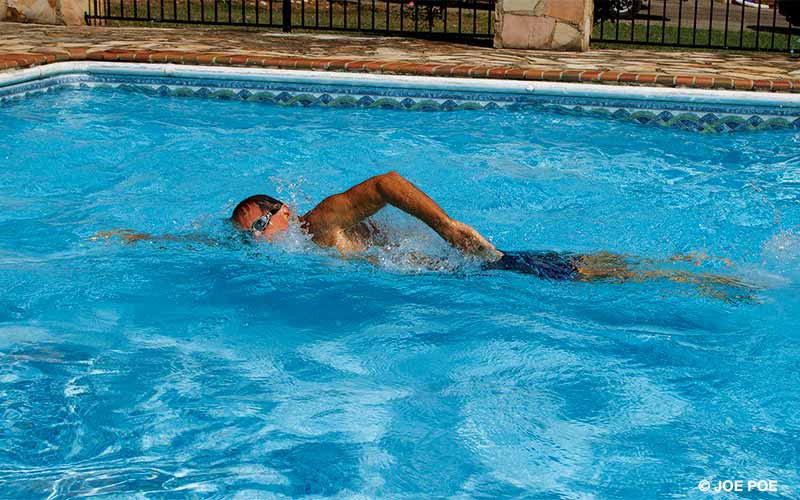
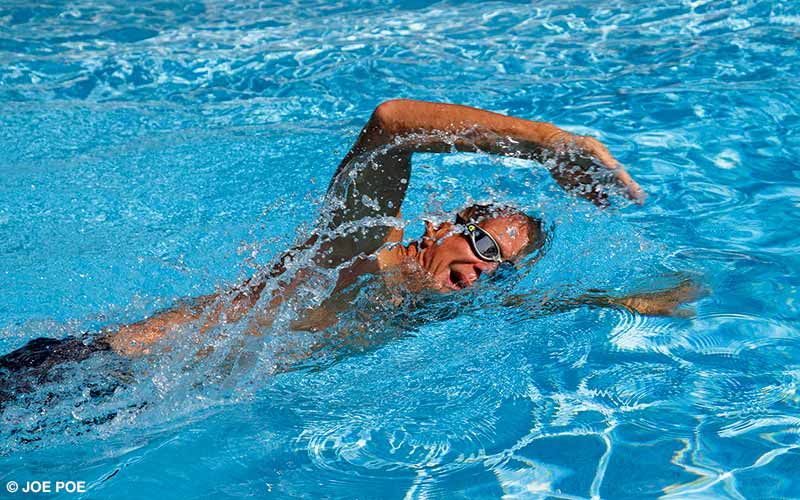
- Maintain a horizontal position in the water by keeping your face down. Some body rotation with each stroke will lower the water resistance; advanced swimmers have significant rotation in their strokes.
- Continuously kick from your hips, similar to finning, while minimizing surface splash.
- Control your breathing by alternating the side you breathe on during a freestyle stroke. Legendary swim coach Bob Bowman (Michael Phelps’ coach) suggests your head should move with your body’s rotation and lift just enough to keep one goggle in the water. Your mouth is inside the bow wake from your forward motion, so it is easy to get air.
- Keep your movements smooth rather than jerky.
Catch-Up Drill

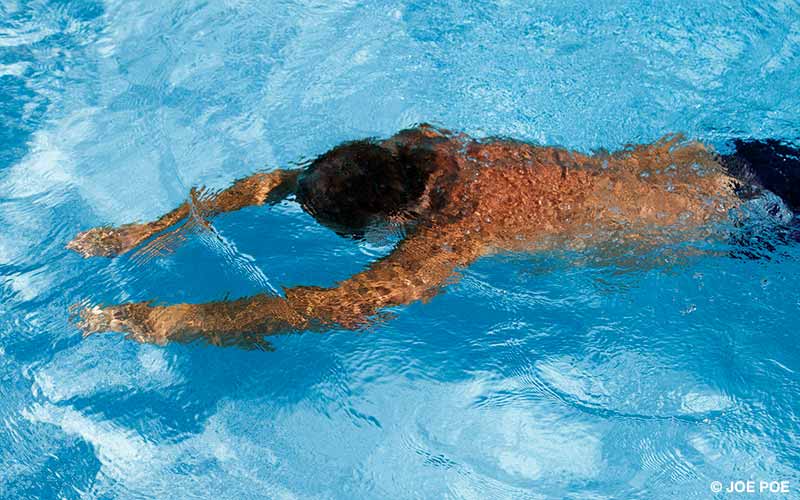
The catch-up drill allows swimmers to work on timing breaths and body rotation.
- Swim freestyle, but maintain a glide.
- Begin your stroke with one hand while the other arm remains outstretched.
- Begin the stroke on the other side once the hand doing the stroke taps the outstretched hand.
Kick Drill
You can do kick drills on your stomach or back, whichever is more comfortable. If doing kick drills on your stomach, try to keep your head down to mimic a horizontal swimming position.

- Hold the kickboard outstretched in front of you.
- Kick from your hips, and make a minimal splash to keep propelling yourself through the water.
Pulls
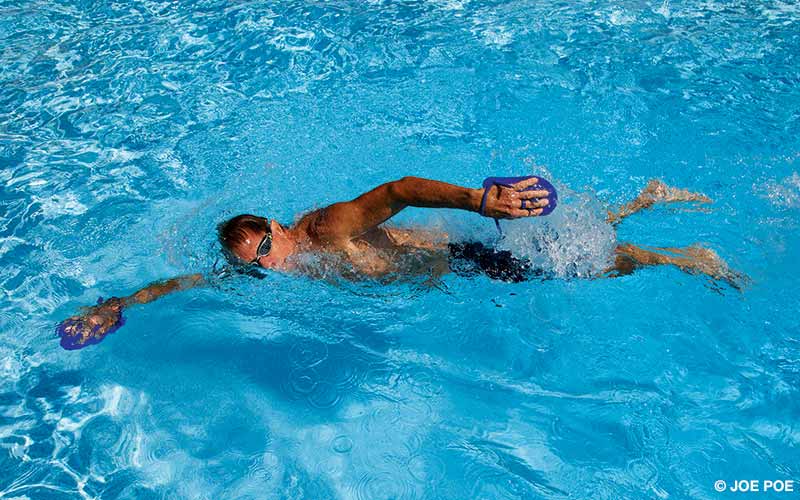
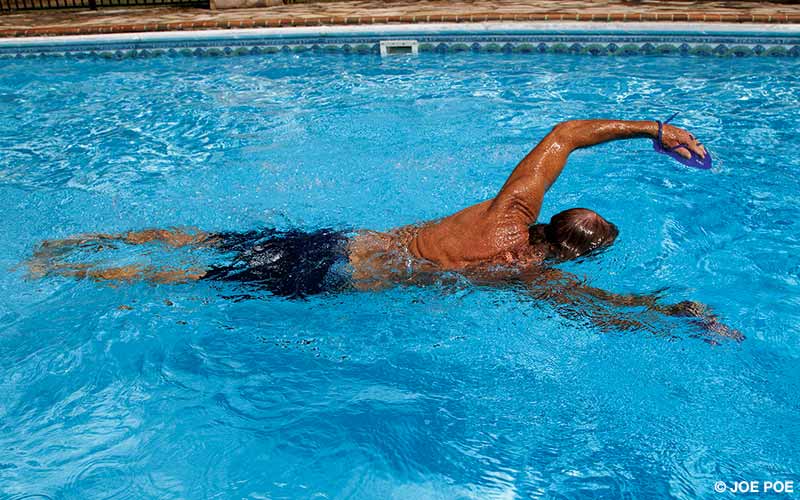
This exercise requires additional equipment options: swim paddles for your hands and a swim training pull to hold between your thighs. Freestyle is the most ergonomic stroke for pulls, but you can try others.
- Concentrate on your hands entering the water with a smooth cleaving motion rather than slapping the water, and use a mostly straight and powerful pull, elbows bent only slightly, for the underwater portion.
- The swim training pull floats the legs and helps minimize the kick, so the shoulders and arms do the work.
Sample 500-Yard Swim Workout
For a challenge, double all distances and consider alternate strokes such as backstroke, butterfly and breaststroke for variety and to use different muscle groups.
Warm-Up
- 4 x 25 yards freestyle (easy pace)
Main Set
- 4 x 25 yards freestyle (medium pace)
- 2 x 25 yards catch-up drill
- 2 x 25 yards kick drill with kickboard
- 4 x 25 yards freestyle (fast pace)
Cool Down
- 4 x 25 yards (easy pace)
Helpful Equipment
- Find a pair of goggles that comfortably fits your face, doesn’t fog and will stay in place. Use clear goggles for indoor swimming and mirrored ones for outdoor sunny days. Goggles are widely available at sporting goods stores and have broad options for fit, tint and antifog, but finding what’s right for you may take trial and error. Many goggles have replaceable nose-bridge inserts so you can customize them to the width of your face.
- A swim cap will help you manage long hair, and a bright color can make it easier for people to spot you while you swim in open water.
- A variety of swim buoys is available for purchase online. They make it easier for people to see you in open water, provide floatation if you need rest, and some even offer personal-item storage.
- Find a comfortable swimsuit that will stay in place, minimize drag and not rub. Style and comfort are personal preferences, and a wide range of appropriate options and styles are available.
Optional Equipment
- Swim fins are beneficial when you’re beginning to swim in open water.
- A swim training pull buoy supports your legs so you can focus on the pulling motion.
- A kickboard allows you to focus on the kicking motion.
- A swim snorkel enables you to fine-tune your pull and kick.
- A training journal helps you track your progress.
- Swim paddles increase resistance and guide you through a clean hand entry.
- Resistance swimming socks are useful when you are ready to increase the challenge.
NOTE: To avoid an increased risk of decompression sickness, DAN® recommends that divers avoid strenuous exercise for 24 hours after making a dive. During your annual physical exam or following any changes in your health status, consult your physician to ensure you have medical clearance to dive.
© Alert Diver — Q3/Q4 2021